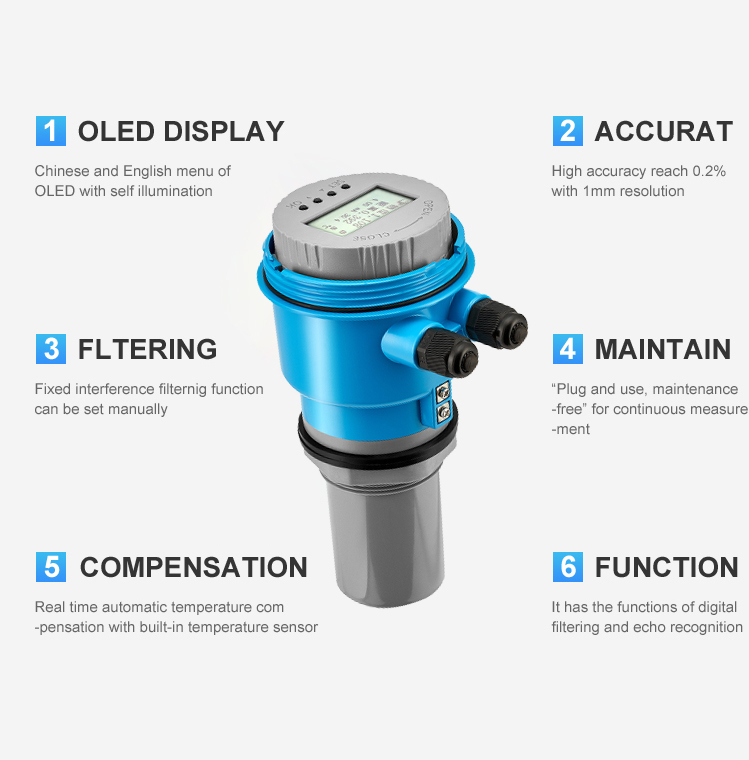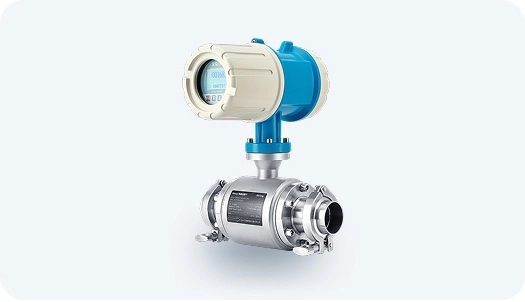-
Date:2025-07-24
-
Page View:153
Ultrasonic level gauge, also known as ultrasonic level meter, ultrasonic water level meter, ultrasonic material level gauge, is an excellent non-contact interface measurement device. It is not affected by the viscosity and density of the liquid. But the accuracy is relatively low, the test is easy to have a blind spot, can not measure the pressure vessel, can not measure volatile media. But the use of reliable performance, maintenance is small. Commonly used in measuring the level of liquid in a variety of containers, as well as drains, pools, reservoirs, rivers, lakes and the sea, such as water level measurement, but also can measure the boundary level, liquid level difference, especially for sewage, corrosive occasions.
The working principle of ultrasonic level gauge
ultrasonic level gauge consists of sensor (probe) and transmitter. The sensor is electrically excited to the measured medium to send an ultrasonic pulse, the pulse through the air to the surface of the medium is reflected back, part of the reflected echo is the same sensor (at this time as a receiver) to accept, and converted into an electrical signal. The electronic detection system of the transmitter detects this signal and converts it into a level signal for display. At the same time, the liquid level signal into 4 ~ 20mA current signal transmitted to the upper computer (PLC) to participate in the process control.
Due to the emitted ultrasonic pulse has a certain width, so that in the sensor near the small section of the region of the reflected wave and the emitted wave overlap, the sensor can not be recognized, can not measure the distance value. This area is called the measurement of the blind spot. The size of the blind spot is related to the type of ultrasonic level meter. The maximum measuring range depends on the attenuation of the ultrasonic waves by air and the intensity of the pulse reflected from the surface of the medium.

What should I do if my ultrasonic level gauge is not measuring correctly?
1. Blind Zone Problem
Ultrasonic level gauges have a minimum measuring distance, i.e. blind zone. If the liquid level is lower than the blind zone, the level gauge can not reflect the signal correctly, resulting in failure to measure.
Solution:
When selecting a level meter, choose a suitable minimum measurement range based on actual needs.
Use a level meter with adjustable range settings to adjust the measurement area.
In the installation position of the level meter, avoid the situation where the liquid level is too low, and consider installing multiple level meters if necessary.
2. Measurement Drift and Temperature Changes
Temperature is an important factor affecting the measurement accuracy of ultrasonic water level meter. The propagation speed of ultrasonic signals is affected by temperature, especially in environments with large temperature differences, which can lead to measurement errors.
Solution:
Select ultrasonic water level meter with temperature compensation function and check the effect of temperature compensation regularly.
Perform regular maintenance on the device to ensure that temperature changes minimize the impact on measurement accuracy.
In extreme temperature environments, consider using other types of level meters, such as radar level meters.
3. Vapor, Bubble and Foam Interference
The propagation of ultrasonic signals will be seriously affected by the presence of a large number of bubbles, foams or vapors on the surface of a liquid. These factors will lead to incomplete signal reflection or error, so that the level meter measurement is not accurate.
Solution:
Add a shroud or reflector plate over the level gauge to reduce signal interference from bubbles and vapors.
Select an installation location that accommodates strong airflow and steam environments, and avoid installing in areas directly exposed to steam or bubbles.
For high steam environments, consider using technologies such as radar level meters, where the radar signal is not affected by steam and can provide more stable measurements. Note, however, that radar level gauges can also be affected by other factors such as the type of medium.
4. Improper installation of the device
ultrasonic water level meter The installation angle, position, and environmental conditions of the device will affect the measurement results. Improper installation can lead to unstable signal transmission, which in turn affects the measurement accuracy.
Solution:
Follow the installation requirements in the product manual to ensure the device is installed vertically.
Avoid installing the device where there are strong air currents, temperature differences, or obstacles.
Regularly check the installation status of the device to ensure that it has not been shifted due to vibration or other external factors.
5. Electromagnetic interference and signal noise
In industrial environments, electromagnetic interference or mechanical noise from equipment may interfere with the reception and transmission of ultrasonic signals, resulting in drifting or unstable measurement results.
Solution:
Enhance the signal processing capability by using an ultrasonic water level meter that is resistant to electromagnetic interference.
Install the level meter away from noise sources such as electrical equipment and transformers.
In a high noise environment, choose an anti-electromagnetic interference model or take good installation isolation measures to ensure stable operation of the equipment.
There are many reasons why ultrasonic level gauges can be inaccurate, ranging from temperature changes to bubble interference to improper installation. By choosing the right equipment, regular calibration, and improving the installation environment, you can effectively improve measurement accuracy and avoid risks in the production process. For complex application scenarios, you can consider introducing other types of level gauges, such as radar level gauges or oscillating fork level gauges, as auxiliary or alternative solutions to ensure measurement stability and accuracy.
If your ultrasonic level gauge is inaccurate, start with environmental factors, installation problems, equipment selection, etc., and regular maintenance and calibration will effectively improve the performance and measurement accuracy of the equipment.










